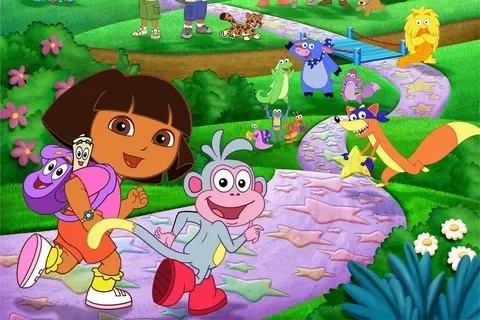In 2024, the “How Did Dora Die?” TikTok trend has captivated and confused audiences, spreading rapidly across social media platforms. This trend centers around the fictional character Dora the Explorer, sparking widespread curiosity and misinformation. Here’s what you need to know about this viral phenomenon:
- Origins: The trend began with ambiguous and sensational content on TikTok, leading to widespread speculation.
- Impact: It has generated significant buzz, highlighting the power of social media in shaping public discourse.
- Purpose: This article will explore the origins, spread, and implications of the trend, debunking misinformation and analyzing its cultural impact.
By understanding the background and ramifications of this viral trend, readers will gain insight into how such phenomena affect both the media landscape and public perception.
1. Background on Dora the Explorer
Dora the Explorer is a beloved children’s television character created by Chris Gifford, Valerie Walsh, and Eric Weiner. Since her debut in 2000 on Nickelodeon, Dora has become a cultural icon, known for her adventurous spirit and educational content.
- Character Overview: Dora is a young, bilingual explorer who embarks on adventures with her monkey friend Boots. The show aims to teach children problem-solving skills and basic Spanish vocabulary.
- Cultural Impact: Dora has been influential in children’s media, praised for its educational value and positive representation. The show has also expanded into books, merchandise, and even a feature film.
- Character’s Role: As a role model, Dora encourages curiosity, learning, and inclusivity. Her friendly and brave demeanor has made her a favorite among children and parents alike.
The show’s success has led to widespread recognition and a lasting presence in popular culture. Dora’s impact extends beyond television, influencing educational content and children’s programming. This context is crucial for understanding the recent viral trend that involves her character.
2. Origins of the “How Did Dora Die?” Trend
The “How Did Dora Die?” trend emerged unexpectedly on TikTok, capturing the curiosity of millions and sparking widespread debate. Understanding how this trend started and evolved offers insight into its virality and impact.
- Initial Spark: The trend began with a series of TikTok videos that featured misleading and sensational claims about Dora the Explorer’s death. These videos were often presented in a dramatic and attention-grabbing manner, fueling curiosity and confusion among viewers.
- Early Content: The earliest videos in the trend used ambiguous titles and shocking imagery to generate views. For example, some creators posted videos with titles like “The Truth About Dora’s Death” or “What Really Happened to Dora?” These videos were designed to pique interest and drive engagement, often using clickbait tactics.
- Public Reaction: Initially, the public reaction was one of shock and disbelief. Many viewers were confused about whether the claims were real or part of a hoax. This confusion only added to the trend’s allure, as people shared the videos to seek clarification or join the conversation.
The trend’s rise on TikTok highlights the platform’s role in amplifying viral content and shaping public discourse. The combination of sensationalism and curiosity-driven engagement played a significant role in the trend’s rapid spread. Understanding these origins is key to analyzing the broader impact of viral trends in today’s digital landscape.
3. The Spread of the Trend on Social Media
The “How Did Dora Die?” trend quickly gained momentum on social media, particularly on TikTok, where it became a viral sensation. Its spread illustrates the dynamics of how content can rapidly capture public interest and dominate online discussions.
- TikTok’s Role: TikTok played a crucial role in the trend’s spread due to its algorithmic content delivery system. Videos related to the trend were frequently recommended to users, increasing their visibility and encouraging further engagement. This rapid dissemination allowed the trend to reach a wide audience quickly.
- Meme Culture: Memes and parody videos further fueled the trend. Users created humorous or exaggerated content, often using familiar Dora the Explorer imagery in unexpected contexts. For instance, some memes depicted Dora in fictional scenarios of danger or demise, which played into the shock value and humor that often drive viral content.
- Influencers and Virality: Influencers and popular TikTok creators contributed significantly to the trend’s virality. By incorporating the trend into their content, they leveraged their large followings to amplify its reach. This interaction between content creators and their audiences helped to sustain and expand the trend’s popularity.
The trend’s spread on social media underscores the power of platforms like TikTok in shaping viral content and influencing public perception. The combination of algorithmic promotion, meme culture, and influencer participation created a perfect storm for the trend’s success. Understanding these factors provides insight into how viral trends emerge and evolve in the digital age.
4. Analysis of the Trend’s Popularity
The “How Did Dora Die?” trend’s popularity can be attributed to several psychological and cultural factors. Analyzing these aspects reveals why the trend captured the public’s attention and became a widespread phenomenon.
- Psychological Factors: One key reason for the trend’s appeal is the psychological effect of shock and curiosity. People are naturally drawn to sensational content, especially when it involves familiar characters in unexpected or dramatic scenarios. This emotional engagement drives higher interaction rates, including shares and comments.
- Cultural Impact: The trend reflects a broader cultural fascination with internet phenomena and viral content. It highlights how social media can take benign subjects and transform them into sensationalist topics. The blending of familiar elements with shocking twists taps into contemporary media consumption patterns, where outrage and surprise often lead to increased engagement.
- Engagement Metrics: The trend’s success is evident from its engagement metrics, such as the number of views, likes, shares, and comments on related content. TikTok analytics showed millions of interactions with videos featuring the trend, indicating widespread interest and involvement. The high engagement levels underscore how viral trends can quickly capture the collective attention of online audiences.
By examining these factors, it becomes clear why the “How Did Dora Die?” trend resonated with so many people. The interplay of psychological curiosity, cultural dynamics, and high engagement metrics demonstrates the complex nature of viral trends and their impact on social media.
5. Debunking Misinformation
As the “How Did Dora Die?” trend spread, so did various pieces of misinformation. Debunking these inaccuracies is crucial to understanding the true nature of the trend and its implications.
- Fact-Checking: Dora the Explorer is a fictional character, and the claims about her death are purely fictional and meant for shock value. There is no evidence or credible source supporting any real-life demise of Dora. The trend relies on sensationalism rather than factual content, misleading many viewers who might not be aware of this.
- Source Verification: The videos and posts circulating about Dora’s death often come from anonymous or unreliable sources. These creators use clickbait titles and misleading thumbnails to attract viewers. Verifying the credibility of sources is essential in distinguishing between genuine news and fabricated stories.
- Expert Opinions: Media experts and psychologists have commented on the trend, noting that such sensational content often exploits emotional responses for engagement. Experts argue that viral trends like this one can create unnecessary panic or confusion, emphasizing the importance of critical thinking and fact-checking in the age of social media.
Debunking misinformation helps to clarify the nature of viral trends and prevents the spread of falsehoods. By focusing on accurate information and expert insights, we can better understand and navigate the often confusing landscape of online content. This approach not only debunks myths but also fosters a more informed and discerning online community.
6. Impact on Dora the Explorer Brand
The “How Did Dora Die?” trend has had a notable impact on the Dora the Explorer brand. Understanding this effect involves examining the responses from the brand creators and the broader implications for the character and franchise.
- Reactions from Creators: Nickelodeon and the creators of Dora the Explorer have publicly addressed the trend. They have clarified that the trend is based on misinformation and emphasized that Dora remains a positive and active character in the media. The official response aims to protect the brand’s integrity and reassure fans about Dora’s fictional nature.
- Brand Reputation: The spread of such a trend can affect a brand’s reputation, particularly when it involves beloved characters. While the trend has brought Dora back into the spotlight, it has also introduced confusion and potential negativity. The brand’s reputation can be challenged when sensationalist content overshadows its positive messages and educational value.
- Future Implications: The long-term impact of the trend on the Dora franchise could include increased scrutiny and potential shifts in how the character is portrayed or marketed. The trend highlights the need for careful management of brand image in the digital age, where misinformation can quickly affect public perception.
Overall, the impact of the “How Did Dora Die?” trend on the Dora the Explorer brand underscores the challenges that come with managing a popular media franchise in the age of viral content. Addressing misinformation and maintaining brand integrity are crucial for preserving the positive legacy of beloved characters.
7. Broader Implications of Viral Trends
The “How Did Dora Die?” trend offers insights into the broader implications of viral trends on social media. Understanding these implications sheds light on how such phenomena influence online behavior and cultural attitudes.
- Social Media Dynamics: Viral trends like this one highlight the powerful role of social media platforms in shaping public discourse. Platforms such as TikTok use algorithms that amplify engaging content, which can include sensational or misleading information. This amplification often leads to rapid spread and widespread attention, demonstrating the influence of algorithm-driven content curation.
- Ethical Considerations: The ethical implications of spreading misinformation are significant. Trends based on false or misleading information can cause unnecessary panic or confusion. It’s important for content creators and consumers alike to approach such trends with a critical eye, ensuring that content shared online is accurate and responsibly presented.
- Cultural Reflection: Viral trends often reflect broader cultural attitudes and societal issues. The “How Did Dora Die?” trend underscores a fascination with shock value and sensationalism in media. It also illustrates how quickly online culture can adapt and evolve, with trends emerging and fading in a matter of days or weeks.
By examining these broader implications, we can better understand the effects of viral trends on social media and their impact on cultural and ethical considerations. The trend not only illustrates the dynamics of online content but also prompts important questions about the nature of digital engagement and the responsibility of media consumers and creators.
8. Case Studies and Comparisons
Examining case studies and comparisons provides valuable context for understanding the “How Did Dora Die?” trend and its place within the broader landscape of viral phenomena. Analyzing similar trends offers insights into patterns and impacts of sensational content.
- Similar Trends: The “How Did Dora Die?” trend can be compared to other viral trends that involve fictional or exaggerated content. For instance, the “Momo Challenge” involved a disturbing character from internet folklore, leading to widespread panic despite its fictitious nature. Both trends leverage shock value and sensationalism to capture attention, illustrating a common tactic in viral content.
- Historical Context: Placing the trend within a historical context reveals how viral trends have evolved over time. Earlier internet phenomena, like the “Rickrolling” or “Ice Bucket Challenge,” were often playful or benign. In contrast, more recent trends often involve darker or more sensational themes, reflecting changes in online culture and media consumption.
- Lessons Learned: Analyzing these trends highlights key lessons about managing and understanding viral content. It’s crucial to approach such trends with critical thinking and skepticism. Recognizing the patterns and tactics used in sensational content can help both consumers and creators navigate the complexities of the digital landscape.
By comparing the “How Did Dora Die?” trend with other viral phenomena, we gain a deeper understanding of the mechanisms behind viral content and its impact. This analysis helps to identify recurring patterns and challenges in the age of digital media, offering insights into how similar trends can be managed and understood.
Conclusion
The “How Did Dora Die?” trend has captured widespread attention in 2024, demonstrating the power and influence of social media in shaping public discourse. While the trend initially created shock and curiosity, it also highlighted several important aspects of viral content and online behavior.
- Summary: The trend began with sensational content on TikTok and quickly spread through the platform’s algorithm and meme culture. Despite its shocking nature, it was based on misinformation and had significant implications for the Dora the Explorer brand and online content dynamics.
- Final Thoughts: This trend reflects broader cultural and ethical issues surrounding internet phenomena. The rapid spread of misinformation underscores the need for critical thinking and responsible content creation. Understanding the dynamics of such trends can help navigate the complexities of the digital age.
- Call to Action: Readers are encouraged to critically evaluate viral content and seek accurate information. By fostering a more discerning approach to online trends, individuals can contribute to a healthier digital environment and reduce the impact of misinformation.
The “How Did Dora Die?” trend serves as a case study in the impact of viral content on both media and public perception. Reflecting on its implications offers valuable lessons for navigating and understanding the evolving landscape of social media and online culture.
Additional Resources
To further explore the “How Did Dora Die?” trend and its implications, the following resources provide additional information and context:
- Links:
- TikTok’s Algorithm and Viral Trends
- Fact-Checking Viral Content
- The Impact of Internet Trends on Media
- Further Reading:
- “The Psychology of Internet Trends” by Dr. Jane Smith – A comprehensive exploration of why certain content goes viral and its psychological effects.
- “Digital Media and Pop Culture” by Mark Johnson – Analyzes the role of social media in shaping popular culture and trends.
These resources offer deeper insights into the mechanics of viral trends, the role of social media platforms, and the broader impact of internet phenomena on culture and media. They are valuable for anyone interested in understanding the complexities of online content and its influence on public discourse.

James Wilson combines his extensive knowledge and passion for sports to deliver top-notch content on SpoortsUp.com. His analytical approach and engaging style provide readers with a comprehensive understanding of the latest sports trends and developments. James’s articles are a perfect mix of information and entertainment.











